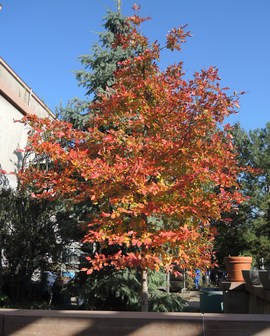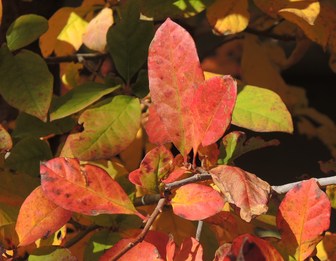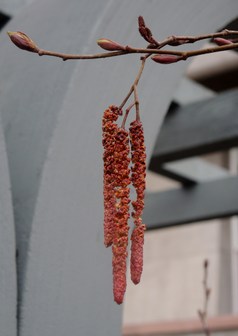Back to Tour: Medicinal Plants Tour
|
Alnus hirsuta 'Harbin' Prairie Horizon™ Manchurian Alder; Siberian Alder |
Denver Botanic Gardens
Gardens Navigator 
|
|
Accession Number: 151864*1 Map | Images | |
| More about Alnus hirsuta 'Harbin' Prairie Horizon™ | |
| TOUR DETAILS |
Medicinal uses: Both leaves and bark have potent astringent properties, which make them useful in treating wounds, but also diarrhea, gastritis and colitis. Alder bark is often made into a solution for mouthwash or gargling that helps fight tooth, gum or throat problems. Alder bark also has anti-microbial properties which are good against infections. The bark has also been known to relieve pain. Mythology/Folklore: Alder trees have long ties with mythology, especially Irish and Scottish mythology. Alder trees tend to grow in marshy areas, or carrs, as they’re called in Ireland. Because the trees are thickly wooded and grow next to water, the Irish believed that you could run into bandits or a boggart in the area. This is why they considered it unlucky to see an alder while on a journey. Because alders grow near water, their wood does not rot in water, in fact, is actually seems to harden when getting wet. This is why Scotts made crannochs, or long boats, out of alders to sail across their many lochs. In fact, most of the city of Venice is built on piles of alder trunks. Medicinal recipes: Alder-Infused Honey Ingredients: dried alder leaves/bark (1-2 tablespoons per 8 ounces of honey), honey Equipment: clean, dry jars and lids, chopstick, wooden spoon handle, or other stirrer (avoid metal, which can scratch jars), clean cloth for wiping jar rims, and a strainer Directions: Herbs should be dry and may be in the form of whole sprigs or separated leaves, buds, and petals. Place herbs in the bottom of a jar and fill the jar almost to the top with honey. Using a chopstick or other implement, stir to coat the herbs with honey. Top off with more honey to fill the jar. Wipe the jar rim with a clean cloth and cover tightly. Let the herbs infuse for at least 5 days. If the herbs float to the top, turn the jar over a few times to keep them well coated. For a more intense flavor, infuse for another week or longer. Strain the honey into a clean jar.Store the honey in a tightly covered jar in a cool, dry place. It will last indefinitely. Culture: (from staff senior horticulturist Angie Andrade) Alder is a very fast-growing tree that prefers a moist wet environment with good soil drainage. Alders produce both female and male flowers on the same tree producing the cutest cones. Basic maint |
| LOCATION GROUP | Sensory Garden |
| FAMILY NAME | Birch Family |
| FAMILY | Betulaceae |
| ACCESSION DATE |
July 16, 2015 (When this plant was acquired and registered in the database) |
| FLOWER COLOR | purple |
| FLOWER COLOR NOTE | purple-brown catkins |
| FRUIT COLOR | brown |
| USDA HZ | 3 (Coldest Zone Where Hardy) |
| HABIT | Tree |
Location Map for 151864*1 Alnus hirsuta 'Harbin' Prairie Horizon™
Map Help
Flowering
When Alnus hirsuta 'Harbin' Prairie Horizon™ has been observed flowering at Denver Botanic Gardens
 | ||||||||||||||||||||||||||||||||||||||||||||||||||||
| 2019 |  |
 |
 |
 |
 |
 |
 |
 |
 |
 |
 |
 |
 |
 |
 |
 |
 |
 |
 |
 |
 |
 |
 |
 |
 |
 |
 |
 |
 |
 |
 |
 |
 |
 |
 |
 |
 |
 |
 |
 |
 |
 |
 |
 |
 |
 |
 |
 |
 |
 |
 |
 |
Images © Denver Botanic Gardens
 151864*1 Alnus hirsuta [Prairie Horizon] = 'Harbin' |
 151864*1 Alnus hirsuta [Prairie Horizon] = 'Harbin' |
 151864*1 Alnus hirsuta [Prairie Horizon] = 'Harbin' Flower |
|
| ^Top of Page |

© Denver Botanic Gardens, 1007 York Street, Denver, CO 80206
Photography © Denver Botanic Gardens

Powered by







 E-mail
E-mail